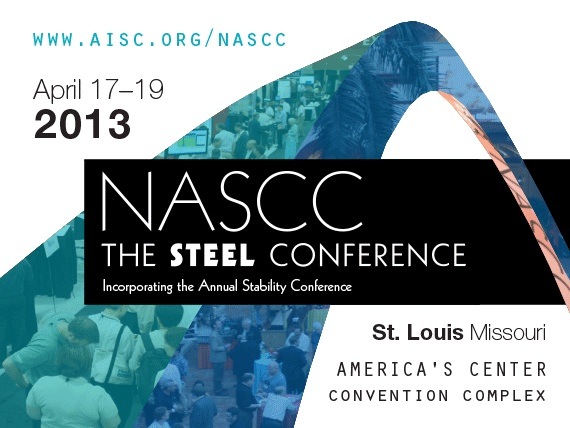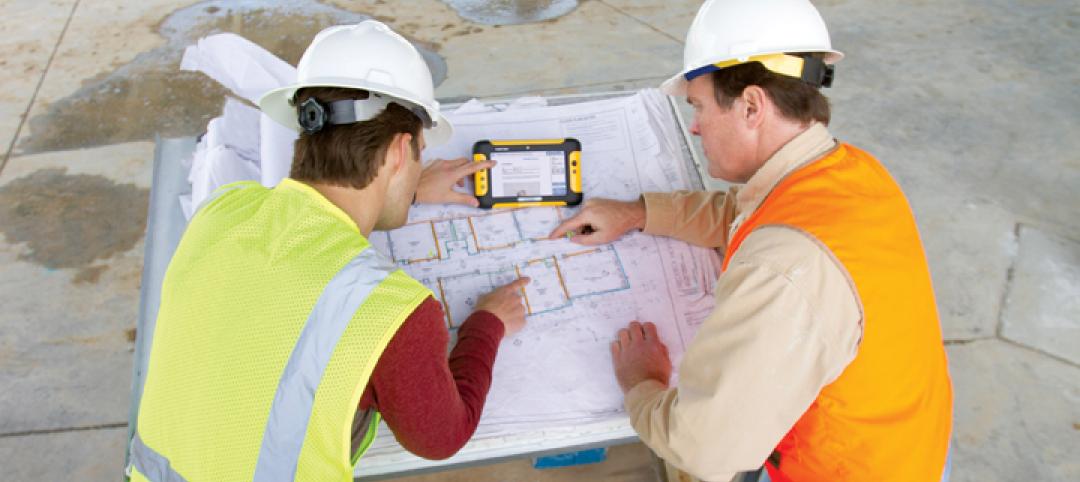On April 17, Michael F. Engestrom, Dann H. Hall, Michael A. West, Stephen A. Mahin, Wallace W. Sanders, Jr., Mark V. Holland, Steven C. Ball, Rafael Sabelli, Judy Liu and William J. Wright will be recognized by the American Institute of Steel Construction (AISC) for their exceptional contributions to the advancement of the structural steel design and construction industry.
Whether it's for an innovative design, an insightful technical paper or a lifetime of outstanding service, these individuals are honored for making a difference in the fabricated structural steel industry's success and will be presented with distinguished AISC awards at the 2013 NASCC: The Steel Conference, April 17-19, at America's Center Convention Complex in St. Louis. To register or view the advance program, visit www.aisc.org/nascc.
AISC's Lifetime Achievement Award gives special recognition to individuals who have provided outstanding service over a sustained period of years to AISC and the structural steel design/construction/academic community. This year's award recipients are:
Michael F. Engestrom, technical marketing director, Nucor-Yamato Steel, for his tireless efforts over more than four decades promoting the use of structural steel and for his support of AISC's technical and market development activities on both the mill and committee levels.
Dann H. Hall, principal, Bridge Software Development International, Ltd., for his leadership in developing software technology for the personal computer to bring the benefits of 3D Finite Element Analysis to the bridge design community. The use of this software has enabled a more complete understanding of horizontally curved and/or skewed steel-girder bridges and allowed for significant advancements in the design of these more complex bridge types. Much of his work has also been incorporated in various AASHTO bridge specifications over the past 20 years.
Michael A. West, P.E., AIA, principal, Computerized Structural Design, for his tireless contributions of knowledge, experience and wisdom to the design community and steel construction industry. He has served as a long-time member of both the AISC Committee on the Code of Standard Practice and the AISC Committee on Manuals, and he serves on Task Committee 13 Quality Control and Assurance of the AISC Committee on Specifications. He also chairs the AISC Committee on Certification Standards. Beyond his formal AISC Committee involvements, he has served as an envoy for AISC in activities with other organizations, including helping to maintain a steel perspective in the concrete document, ACI 117, for when the two materials meet.
Stephen A. Mahin, Ph.D., professor, University of California, Berkeley, for his major contributions to structural steel research throughout his career, including steel braced frames. He has been a leader in developing cooperative research activities through the Partnership for Advanced Steel Structures and the NSF U.S.-Japan Cooperative Earthquake Research Program using large-scale facilities for composite and hybrid structures. He has also served on various AISC Seismic Committees over the past two decades and is currently a corresponding member of the AISC Task Committee 9 – Seismic Design. In 2001, he received an AISC Special Achievement Award for his leadership on the FEMA/SAC initiative for reduction of earthquake hazards in steel moment frame structures.
Wallace W. Sanders, Jr., Ph.D., professor emeritus, Iowa State University, who has served as a passionate advocate for engineering education with an emphasis on steel bridge design during his 34 years on the faculty at Iowa State University. He has furthered the knowledge of steel construction through his involvement with the American Welding Society (AWS) and has contributed to AISC as a member of the Partners in Education Committee. He currently serves as a member and secretary of the AREMA Steel Bridge Committee. Sanders also contributed to the construction of the strong floor in the structural engineering laboratory at Iowa State University, which is named in honor of him and his wife Julia. His research has advanced the state-of-the-art in load distribution and strengthening for steel bridges as well as fatigue.
AISC's Special Achievement Award recognizes individuals who have demonstrated notable achievements in structural steel design, construction, research or education. It honors those who have made a positive and substantial impact on the structural steel design and construction industry. This year's award recipients are:
Mark V. Holland, P.E., chief engineer, Paxton & Vierling Steel Co., for his leadership in interoperability since the very beginning of AISC's effort in 1997. He has provided countless hours of volunteer work and leadership on CIS/2, EDI, and interoperability, and has brought attention to this crucial subject through his committee work and conference presentations. In addition, he and his firm have served as leaders in the practical implementation of BIM.
Steven C. Ball, S.E., vice president, John A. Martin & Associates, Inc., for his creative and bold structural engineering work in the application, testing and qualification of long-span steel Special Moment Frames with non-orthogonal connections in California for the Tom Bradley International Terminal (TBIT) Program at Los Angeles International Airport (LAX). The structural solution required Special Moment Frame geometry that had never been used before in the U.S. in a high seismic region. This type of creative and unconventional structural solution was required to achieve the unique architectural expression and large, open spaces central to this highly complex, sustainable building. His unwavering efforts pave the way for future testing for prequalified implementation of structural steel moment frame solutions for architecturally challenging projects.
Rafael Sabelli, S.E., principal and director of seismic design, Walter P Moore, for his contributions to the literature on seismic design of steel and composite structures, both as an author and as chair of the seismic subcommittee of the AISC Committee on Manuals. He has been involved in various textbooks on seismic steel design, design guides and the widely used AISC Seismic Design Manual.
Judy Liu, Ph.D., associate professor, Purdue University, for her contributions toward improving structural steel education in universities through her development and maintenance of web enhanced teaching, her contributions to the Partners in Education committee and through the Tip Sheet newsletter.
William J. Wright, Ph.D., P.E., associate professor, Virginia Tech, for his contributions in the areas of fatigue and fracture behavior of structural steel, curved girder bridges and forensic investigations. His research has significantly advanced the understanding associated with constraint induced fracture, fracture toughness properties of high performance steel and the identification and system performance of fracture critical steel bridge systems.
About the American Institute of Steel Construction
The American Institute of Steel Construction, headquartered in Chicago, is a not-for-profit technical institute and trade association established in 1921 to serve the structural steel design community and construction industry. AISC's mission is to make structural steel the material of choice by being the leader in structural steel-related technical and market-building activities, including: specification and code development, research, education, technical assistance, quality certification, standardization, and market development. AISC has a long tradition of service to the steel construction industry of providing timely and reliable information.
Related Stories
| Aug 24, 2011
Deadline Extended: 2012 "Best AEC Firms to Work For” Awards
We’re looking for firms that create truly positive workplaces for their AEC professionals and support staff. In other words, this awards program will recognize those AEC firms that nurture and develop their most valuable asset—their people.
| Jul 21, 2011
Bringing BIM to the field
A new tablet device for construction professionals puts 3D data at the fingertips of project managers and construction supervisors.
| May 25, 2011
Register today for BD+C’s June 8th webinar on restoration and reconstruction projects
Based on new and award-winning building projects, this webinar presents our “expert faculty” to examine the key issues affecting project owners, designers and contractors in case studies ranging from gut renovations and adaptive reuses to restorations and retrofits.
| May 25, 2011
Developers push Manhattan office construction
Manhattan developers are planning the city's biggest decade of office construction since the 1980s, betting on rising demand for modern space even with tenants unsigned and the availability of financing more limited. More than 25 million sf of projects are under construction or may be built in the next nine years.
| May 25, 2011
Olympic site spurs green building movement in UK
London's environmentally friendly 2012 Olympic venues are fuelling a green building movement in Britain.
| May 19, 2011
BD+C’s "40 Under 40" winners for 2011
The 40 individuals profiled here are some of the brightest stars in the AEC universe—and they’re under the age of 40. These young architects, engineers, contractors, designers, and developers stood out among a group of 164 outstanding entrants in our sixth annual “40 Under 40” competition.
| May 18, 2011
8 Tips for Designing Wood Trusses
Successful metal-plate-connected wood truss projects require careful attention to detail from Building Team members.
| May 18, 2011
Major Trends in University Residence Halls
They’re not ‘dorms’ anymore. Today’s collegiate housing facilities are lively, state-of-the-art, and green—and a growing sector for Building Teams to explore.
| May 18, 2011
Former Bronx railyard redeveloped as shared education campus
Four schools find strength in numbers at the new 2,310-student Mott Haven Campus in New York City. The schools—three high schools and a K-4 elementary school—coexist on the 6.5-acre South Bronx campus, which was once a railyard.

















